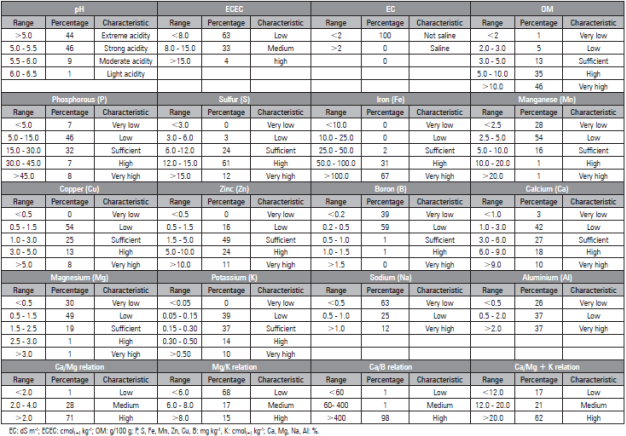INTRODUCTION
In 2019, Colombia produced 4,376,922 t of plantain and reported a cultivation area of 450,329 ha, with Arauca as the leading producer department, followed by the departments of Antioquia, Meta, and Valle del Cauca. Cundinamarca ranked 12st with a cultivated area of 12,234 ha and a production of 102,350 t (Agronet, 2020).
Phytosanitary problems in any crop cause a decrease in production, a reduction in the quality of the final product, and, in extreme cases, depending on the causal agent, a total loss of the plantation crop. Plantain production in Colombia is exposed to phytosanitary problems as the result of the attack of fungi, bacteria, viruses, and phytoparasitic nematodes, among others. In this sense, bacteriosis or wet rot and moko are caused by the bacterial species Dickeya sp. and Ralstonia solanacearum Race 2, respectively.
Dickeya sp. degrades tissues and releases cellular fluids that attract secondary bacteria, which proliferate in the cells and often release unpleasant odors. Pathogens that cause soft rot secrete extracellular enzymes, such as pectate lyases, cellulases, nucleases, and proteases, that degrade pectin, cellulose, nucleic acid, and cellular proteins, respectively (Kado, 2016a). This species survives mainly in the tissue of diseased plants, crop residues, soil and compost (Kado, 2016a); it generally appears during the summer season, generating losses of up to 100% on plantations where adequate management measures are not implemented (Aránzazu et al., 2002). Initially, plants affected by bacteriosis show necrosis at the edge of the oldest leaves, which progresses to the entire leaf blade, causing total chlorosis (Alarcón and Jiménez, 2012). If the bacterium spreads rapidly, the plant dies with its brown, dead leaves remaining erect, and the older leaves often fall while green, with the younger center leaves turning yellow (Jones, 2018). However, in Colombia, the primary symptomatology is observed in the pseudostem, where aqueous rot develops, accompanied by translucent spots with a yellowish color at the beginning that later turn reddish to dark brown. This weakens the middle part of the plant, accompanied by a strong foul odor that attracts pests (weevils), aggravating the problem by disseminating the bacterium on the plantation (Aránzazu et al., 2002; Alarcón and Jiménez, 2012).
On the other hand, R. solanacearum Race 2 is one of the more destructive bacteria in the world, with a negative impact on banana and plantain production systems in the tropics and warm temperate zones (Kado, 2016b). In Colombia, losses generated by attack of this bacterium in musaceas can range up to 100% since the fruits are severely affected; moreover, higher management costs are related to the application of eradication measures and quarantine times (Yabuuchi et al., 1992; Castañeda and Espinosa, 2005; Bejarano, 2010). In plantain cultivation, this bacterium attacks in any physiological state of the plant, moving downwards through mechanical damage caused by an infected tool or by insect attack on the branch or upwards when penetrating the root system or pseudostem through wounds (Hurtado, 2012). Once inside the tissue, the vascular parenchyma and the xylem get infected, and exopolysaccharides (acidic extracellular polysaccharide - EPS I) and β-1,4-endoglucanase are produced when exceeding 107 cells/mL, promoting bacterial colonization of the plant (Kado, 2016b), vascular bundle blockage, weakening through water and nutrient deficiency, wilting, and, finally, plant death.
According to Álvarez et al. (2015), in newly planted seedlings affected by moko disease, widespread yellowing appears with subsequent necrosis and when the pseudostem is cut, and a few reddish spots or brown lines appear, corresponding to the vascular bundles where the pathogenic bacterium has degraded tissues. In young plants, dry leaves appear in the middle of asymptomatic leaves or the flag leaf appears completely necrosed. When cutting the rachis, fruits, pseudostem, or corms, internal damage can be observed as lesions that are, at first, pale yellow, becoming reddish brown, and then black. When attack is late or transmission is by vector insects to the bunch, reddish or black coloration appears in the affected plantain fingers; upon cutting across the rachis, spots can be seen, corresponding to infected vascular bundles through which the bacterium has moved throughout the plant.
The integrated management of these two diseases involves prevention measures, such as disinfection of tools and footwear, weed control, and use of healthy seeds. Furthermore, the implementation of cultural practices, such as removing dry leaf sheaths, management of the weevils-worm screws complex, and, after identifying symptoms on plantations, zoning the plots and implementing the management schemes recommended by Corporación Colombiana de Investigación Agopecuaria - AGROSAVIA (Formerly CORPOICA), CIAT and ICA (Aránzazu et al., 2002; Álvarez et al., 2007, 2013; Alarcón and Jiménez, 2012). Additionally, managing phytosanitary problems as reported by other authors in Colombia (Aránzazu et al., 2002; Alarcón and Jiménez, 2012; Ramírez et al., 2014; Bautista-Montealegre et al., 2016) requires analyzing plant nutrition and soil fertility in pathogen-plant interactions.
In accordance with the latter, adequate crop nutrition contributes to a reduction of disease attacks (Méndez and Viteri, 2007; Viteri et al., 2012; Bautista-Montealegre et al., 2017) and is directly related to the occurrence of plant resistance and predisposition factors according to nutritional imbalances (Chaboussou, 1967). Deficiencies in crop nutrition can increase susceptibility to various diseases and, therefore, increase aggressiveness seen in weak infections (Huber, 1997; Velasco, 2000; McMahon, 2012).
Accordingly, the aim of this study was to analyze the incidence of bacteriosis and moko diseases in the plantain cultivar Dominico Harton (Musa AAB Simmonds) in four producing municipalities in the Department of Cundinamarca and its relationship with chemical soil properties and foliar nutrient concentrations.
MATERIALS AND METHODS
This study was carried out in the municipalities of Chaguani, La Palma, La Vega and Viota, located in the Department of Cundinamarca. The latter is located in the Andean region, on the eastern mountain range (Cordillera) of the Colombian central area, between 3°42' - 5°51' N and 73°3' - 74°54' W (IGAC, 1999). One hundred forty-nine (149) previously selected plantain farms were visited and georeferenced with a Global Positioning System (GPS) (Garmin® brand). These farms are in areas that register average temperatures of 16 to 26°C, precipitation of 900 to 2750 mm year-1, relative humidity of 75 to 85% (AGROSAVIA, 2020) and altitudes of 1,121 to 1,770 m a.s.l. (Tab. 1).
Table 1 Biophysical characteristics of the territory and number of plantain farms visited by municipality in the Department of Cundinamarca.

The incidence of bacteriosis and moko diseases in the department was calculated from visual observation in the field of internal and external symptoms of randomly selected plants, qualifying the farms as healthy or sick according to the presence of characteristic symptoms described by Aránzazu et al. (2002), Alarcón and Jiménez (2012) and Álvarez et al. (2015).
Moreover, soil samples were collected from each farm according to the methodology described by Bolaños (2006) for chemical analysis. Plant tissue samples were obtained by taking 10 cm at the middle of the third leaf from the flag leaf on each farm for nutrient concentration analysis. The collected samples were processed according to the protocols of the analytical chemistry laboratory of AGROSAVIA at the Tibaitata Research Center in Mosquera (Cundinamarca), following norm NTC ISO/IEC 17025.
Once the laboratory results were obtained, a descriptive analysis of the chemical properties of the soil and the foliar concentration of nutrients was carried out by analyzing the range frequency according to the classification published by ICA (1992), along with the macro and micronutrient approximations in foliar tissues by Munson (1998)). Additionally, the data were subjected to comparison of means for independent groups using the t-Student-Welch test with a level of significance of P<0.05. Finally, ArcGIS 10.3 (ESRI ®) was used according to the sampling carried out to cartographically represent the distribution patterns of the diseases in the field.
RESULTS AND DISCUSSION
Incidence of Dickeya sp. and R. solanacearum
Of the total number of farms evaluated in four municipalities, 63 and 14% of these farms were affected by bacteriosis and moko, respectively. In the case of bacteriosis, a higher number of sick plants were observed on farms in the municipalities of La Vega and Viota, followed by the municipalities of Chaguani and La Palma, with reports of 36, 25, 18 and 16 farms, respectively. However, the incidence of the disease was higher in the municipalities of Viota and La Palma, with 68 and 67%, followed by the municipalities of Chaguani and La Vega with 62 and 50%, respectively (Fig. 1).
On the other hand, more plants were observed on farms affected by moko in the municipalities of Viota and La Vega, with 16 and 6, respectively, while the municipalities of La Palma and Chaguani did not report the presence of this disease. Hence, the incidence was higher in the municipality of Viota with 30%, followed by the municipality of La Vega with 14% (Fig. 1).
In the municipality of Chaguani, the presence of bacteriosis was confirmed on the eastern edge of the municipality in the veredas (settlements) Llanadas, Montefrio, and El Rincon, while, in the municipality of La Palma, the majority of the farms reported bacteriosis in the southern part of the municipality (Fig. 2).
The plantations affected by bacteriosis in the municipality of La Vega were concentrated in settlement El Chupal, with isolated cases in settlement Hoya Grande, while the presence of moko on the plantations was on the northern edge of settlement Naguy, and only one case was found in the southwest of settlement El Chupal (Fig. 2).
Finally, in the municipality of Viota, settlement Bajo Ceilan reported a higher number of plantations affected by both diseases; additionally, in this settlement, there were several farms with the presence of only one of the diseases. Both in Bajo Palmar and Mogambo, the most prevalent phytosanitary problem was bacteriosis, which was concentrated in the southern part (Fig. 2).
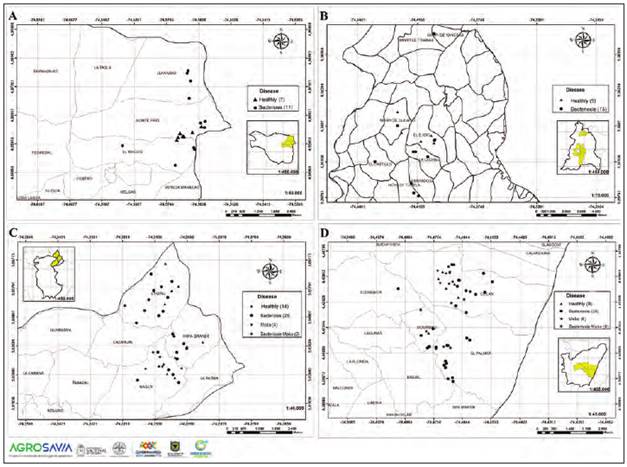
Figure 2 Spatial distribution of the bacterial diseases bacteriosis and moko on the Dominico-Harton plantain farms in the municipalities of Chaguani (A), La Palma (B), La Vega (C) and Viota (D), in the Department of Cundinamarca
The diseases evaluated in the municipalities did not show a defined distribution pattern (Fig. 2), and their dispersion was possibly influenced by specific epidemiological aspects of each pathogen, as well as by biophysical and sociocultural conditions and crop management techniques. The epidemiology of the diseases, in the case of bacteriosis, was focused on the endemic nature of the bacterium and its ability to develop and establish in a wide range of temperatures (i.e., 5, 22 and 37°C for minimum, optimum and maximum temperatures, respectively), as well as long periods of drought alternated with heavy rains (Alarcón and Jiménez, 2012), particularly if the ground is poorly drained, cool, and plants are waterlogged (Jones, 2018). Furthermore, other factors that stand out are the survival of the pathogen in alternate hosts and plant debris that remain attached to the pseudostem as the result of defoliation (Martínez and García, 2003), high incidence of insects such as Metamasius hemipterus L. (Coleoptera: Curculionidae) and nutritional imbalances, especially considering elements such as potassium and boron (Belalcázar, 1991; Bolaños-Benavides and Benalcázar-Carvajal, 2000; Aránzazu et al., 2002).
For moko in plantain, although its incidence in the municipalities was low (14%), its prevalence and spread to new areas or farms is possible because of transmission by insect vectors and movement of infected material from other affected areas (Álvarez et al., 2015). According to a study carried out by Cardona et al. (2017) in which technical and socioeconomic particularities of the productive system were established in the same municipalities studied in the instant research, non-disinfestation of tools, highly variable disease management strategies and use of seeds from the same farm are related to the presence of bacteriosis and moko in plantain. This translates into a constant threat to plantain production in producing areas, particularly since management decisions are made based on traditional knowledge or the recommendation of other farmers.
Chemical soil properties and foliar nutrient concentrations
According to the descriptive analysis of the chemical characteristics of all soils sampled (Tab. 2), the results were: a higher frequency of extreme to strong acidity (44-46%, respectively); low effective cation exchange capacity (63%); non-saline soils for electrical conductivity of less than two (100%); very low sodium content (63%); low levels of phosphorus (46%), magnesium (54%), copper (54%), boron (59%), calcium (42%), manganese (49%), potassium (39%) and the magnesium potassium ratio (68%); sufficient zinc content (49%) as well as high sulfur content (61%), and high values for calcium/magnesium, calcium/boron and calcium/magnesium + potassium ratios (71, 98 and 62%, respectively); moreover, there were very high contents of organic matter (46%) and iron (67%) and low to very high aluminum concentration frequencies (37%).
The nutrient concentration in foliar tissue collected to evaluate bacteriosis and moko on the plantain farms (Tab. 3 and Tab. 4, respectively) showed frequent deficits of nitrogen (61 and 62%, respectively), phosphorus (60 and 63%, respectively), sulfur (82 and 84%, respectively), copper (92 and 95%, respectively), zinc (95 and 97%, respectively) and boron (90 and 69%, respectively). The plantain foliar tissue showed normal concentrations of calcium (94 and 86%, respectively), potassium (91 and 88%, respectively), iron (96 and 86%, respectively), magnesium (62 and 63%, respectively) and manganese (65 and 60%, respectively).
However, the student's t-test, used to compare the health of the crops on the farms and the chemical properties of the soil, showed statistically significant differences (P<0.05) in the content of sulfur affected by bacteriosis (8.28) and in the content of zinc (4.17) affected by moko; these values were low when compared with the concentration in the farm soils without the diseases (S: 10.36 and Zn: 6.37) (Tab. 5).
Table 3 Approximate concentration ranges of macro and micronutrients in foliar tissues of plants evaluated for bacteriosis symptoms on 149 plantain farms.
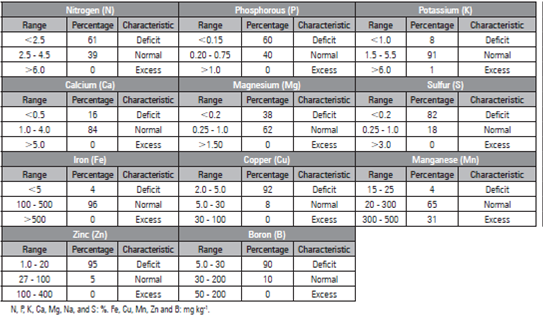
Table 4 Approximate concentration ranges of macro and micronutrients in foliar tissues of total plants evaluated for moko symptoms on 149 plantain farms.
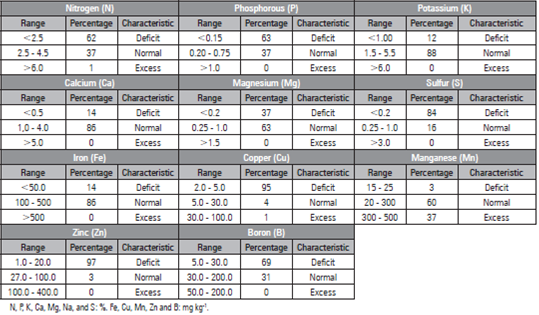
Table 5 Chemical soil properties from 149 plantain farms according to the presence and absence of bacteriosis and moko.
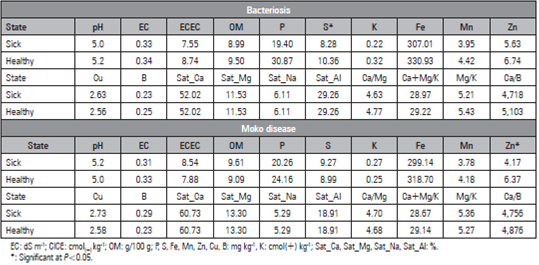
As seen in the soil results and the importance of its availability for plants, S is a constituent of proteins and amino acids, such as cysteine and methionine; these amino acids are precursors of other compounds that contain this element, such as coenzymes and plant subproducts, which are directly involved in metabolic reactions (Hawkesford et al., 2012). This element has been recognized in the control of diseases through its use as a fungicide, which was initially implemented in the agricultural sector in 1847 for the control of Oidium in vineyards (Paul, 1978). Further, for vascular diseases, researchers have demonstrated that levels of S accumulation in vascular tissue were fungitoxic for Verticillium dahliae in tomato plants, inhibiting spore germination and growth of fungal hyphae (Williams et al., 2002), whilst, in tobacco and French bean susceptible to Fusarium oxysporum and tomato susceptible to R. solanacearum, sulphur was detected in xylem excised from infected plants but not in controlled plants (Williams and Cooper, 2003).
Zn is the second most abundant transition metal in living organisms, after Fe; the metabolic functions of Zn are based on its strong tendency to form tetrahedral complexes with N, O, and, mainly, S ligands, playing a functional and structural role in enzymatic reactions. Additionally, it is related to protein molecules involved in DNA replication and the regulation of gene expression. Further, the metabolic changes induced by a Zn deficiency are complex. However, some can be explained by the functions of this element in enzymatic and metabolic reactions, so when they affect the expression and regulation of defense mechanisms of genes and proteins, Zn contributes to the tolerance of plants to environmental stressors (Broadley et al., 2012).
In the foliar tissue, the concentration of nutrients showed significant differences (P<0.05) for K, Ca and Mn in the plants with bacteriosis, while the plants with symptoms of moko had differences in the concentrations of N, Ca, Na and Cu (Tab. 6). The plants free of bacteriosis showed a higher concentration of K and lower concentrations of Ca and Zn, while the plants free of moko showed higher concentrations of N, Na and Cu and a lower concentration of Ca (Tab. 6).
Table 6 Foliar nutrient concentration from 149 plantain farms according to the presence and absence of bacteriosis and moko.

Bacteria such as Dickeya sp. that produce soft rot release polygalacturonase and pectolytic enzymes as they spread within the tissues of the host, while vascular diseases such as moko caused by R. solanacearum spread within plants through the xylem and lead to the formation of "slime" that clogs the vessels (Huber et al., 2012). Calcium and manganese are related to the resistance of plants to bacterial diseases through stabilization of the medium lamella, inhibition the formation of pectolytic enzymes and decrease in accumulation of sugars and amino acids in the apoplast in the case of Ca, along with hypersensitivity responses to infections by activation of enzymes in the case of Zn (Humphries et al., 2006; Huber et al., 2012; Gupta et al., 2017; Schumann et al., 2017).
However, the response of plants to these elements is affected to some extent by how they are applied, as well as by changes in pH and use of chemical molecules as herbicides (Huber et al., 2012; Rahman and Punja, 2007). For Dickeya sp. in plantain cultivation, authors have reported that a K deficiency predisposes plants to attacks by this pathogen (Bolaños-Benavides and Belalcázar-Carvajal, 2000; Aránzazu et al., 2002; Alarcón and Jiménez, 2012). Consequently, the results coincide with the results reported by Bolaños-Benavides and Benalcázar-Carvajal (2000). These authors studied the relationship between the attack of bacteriosis and the concentration of nutrients in tissue and soils, finding that, in addition to K, plantain plants affected by disease have low contents of N, P, Mn, B, and Zn. Moreover, no correlation between the concentration of nutrients in soil and plant tissues was found.
Physiologically, K is essential to metabolic processes and influences membrane potential, cell turgor, carbohydrate translocation, protein synthesis, osmoregulatory activities and enzyme catalysis (Mengel, 2007; Pyo et al., 2010). Its importance has been demonstrated because its deficiency facilitates the entry and development of pathogens through physical and metabolic changes that counteract the natural defense mechanisms of plants (Amtmann et al., 2008).
The influence of N on susceptibility to diseases is related to the metabolic aspects of plants, the effect on the virulence of phytopathogenic microorganisms, and abiotic and biotic factors (Huber and Thompson, 2007). However, results may be inconsistent because it has not been clearly established whether the effect presents when the nutrient supply is low, optimal or excessive, if the effect depends on the form of N supplied (ammonium or nitrate that are metabolized differently), or if there are differences between infection patterns of obligate and facultative parasites (Huber et al., 2012). Although excess N is related to attacks by pathogens, mainly foliar, the susceptibility of plants to bacterial spots caused by a facultative parasite decreases with an increase in N supply, as reported for Xanthomonas vesicatoria in tomato plants (Huber et al., 2012).
On the other hand, the results observed in the current research for the concentration of foliar Cu in the plants without moko symptoms coincide with the results reported by Bautista-Montealegre et al. (2016), who found a low probability of occurrence of the disease in plants with a high concentration of this element at the leaf level. This response might be due to the effect of Cu on the lignification of the xylem in photosynthetic processes, in the transfer of electrons and oxidative proteins, as well as in the synthesis of DNA-RNA (Evans et al., 2006; Broadley et al., 2012). There is some uncertainty about the effect of Na as a nutrient and as a disease suppressant, partly because of the semantics of "essentiality" (Reid et al., 2001; Gorham, 2006), and it is only considered a beneficial nutrient when it influences the stimulation of growth and interaction with other nutrients (Gorham, 2006). However, excess Na in soil and plants causes restricted growth of the root, marginal burning, or at the tip, of leaves, inhibition of flowering and reduction of crop yield (Greenway and Munns, 1980). Conversely, positive effects are attributed to the control of diseases caused by vascular-type soil pathogens by decreasing damage and increasing dry matter production (Reid et al., 2001; Okada and Matsubara, 2012; Matsubara et al. 2015).
CONCLUSION
All evaluated farms in the Department of Cundinamarca registered incidences of 63 and 14% for bacteriosis and moko, respectively, with the highest presence in the municipalities of Viota and La Vega.
The information collected on the diseases evaluated in the municipalities did not show a defined distribution pattern, and their dispersion was possibly influenced by the soil fertility and the nutritional status of the plants, as well as by the epidemiological aspects and management practices carried out by the plantain producers.
The farm soils cultivated with plantain in the four municipalities of Cundinamarca had an extreme to strong acidity and low effective cation exchange capacity; moreover, the non-saline soils had low concentrations of most elements. The plantain plants had a deficit of elements such as nitrogen, phosphorus, sulfur, copper, zinc, and boron.
Soils from the plantain farms with low concentrations of sulfur and zinc reported the presence of bacteriosis and moko, respectively. The plants free of bacteriosis showed a higher concentration of potassium and lower concentrations of calcium and manganese; while the plants free of moko showed higher concentrations of nitrogen, sodium, and copper and a low concentration of calcium.
The spatial distribution analysis of the bacterial diseases can contribute to the planning of management strategies on a large scale to reduce the risk of dissemination of phytosanitary problems of economic importance in plantains, such as bacteriosis and moko.
Although the incidence of moko in plantain in the Department of Cundinamarca was low (14%), as compared to bacteriosis (64%), attention should be paid to this disease because, if adequate control measures are not implemented, Musaceae productivity in the studied municipalities may be compromised.
Nonetheless, it is recommended that the exploratory scale or number of evaluated farms be expanded to more precisely determine the distribution of bacteriosis and moko, as well as the current phytosanitary situation of plantain production systems in the main producing municipalities of the Department of Cundinamarca.
The soil and nutritional requirements of plantain must be analyzed to implement nutritional management of this productive system in the Department of Cundinamarca since a nutritional imbalance in the soil matrix and a deficiency of some nutrients in the plants can influence tolerance to bacteriosis and moko.
Local entities in the municipalities of La Vega, Viota, Chaguani, and La Palma should work jointly with producers in the adoption of recommended integrated diseases management schemes to reduce the impact on plantations.





![Pitaya fruit quality (Hylocereus undatus [Haworth] Britton & Rose) according to physiological maturity. A review](/img/en/next.gif)









